Physical Address
304 North Cardinal St.
Dorchester Center, MA 02124
There has been a dramatic rise in popularity of aesthetic gluteal contouring in both weight loss and non-weight loss patients.
While most procedures performed today are autologous fat transfer and implant procedures, some gluteal deformities including skin excess or buttock ptosis demand alternative body contouring solutions.
Several techniques for autologous gluteal autoaugmentation with circumferential bodylift and excisional buttock lifts are used.
Three categories of autologous flaps are described in this chapter: island flaps, what the senior author describes as incremental flaps, and transpositional flaps.
Access video lecture content for this chapter online at Elsevier eBooks+ ![]()
The ongoing demand for bariatric surgery procedures and its effect on massive weight loss (MWL) patients presenting with severe body contour deformities has unexpectedly driven demand for gluteal contouring procedures. Changing sociocultural gluteal aesthetic norms and exposure in popular culture media channels has also increased demand for aesthetic gluteal contouring procedures across the US. While most procedures performed today are autologous fat transfer and implant procedures, the MWL patient can present with unique gluteal deformities demanding alternative body-contouring solutions. The dramatic rise in popularity of aesthetic gluteal contouring has also increased the demand for circumferential bodylifts and excisional buttock lifts with autoaugmentation in weight loss patients and non-weight loss patients with significant skin laxity or hypoplasia. Several techniques for autologous gluteal autoaugmentation (AGA) with circumferential bodylift (CBL) and excisional buttock lifts (EBL) have been posited as a solution to this problem. Three general categories of autologous flaps are described in this chapter: island flaps, what the senior author describes as incremental flaps, and transpositional flaps. Experience and knowledge of the variety of techniques will allow expanded application to the aesthetic patient presenting with gluteal hypoplasia in addition to the MWL population. Indications, technical variations, surgical planning, results, complications, and postoperative management are discussed.
As one ages, anatomic changes that occur in the torso and gluteal region contribute to decreased gluteal projection and aesthetics. Accumulation of subcutaneous fat in areas surrounding the gluteal region detracts from the aesthetic appearance of the buttock. The accumulation of intra-abdominal fat in women that accompanies perimenopausal changes coupled with rectus diastasis negatively affects the contour of the torso. Age-related skin laxity and ptosis of the subcutaneous fat also decreases projection of the gluteal region. Dramatic loss of adipose volume in the buttock of weight loss patients uniquely contributes to decreased projection and ptosis. The average female patient gets wider at the hips and the infragluteal crease lengthens with age. Many of these findings prompt aesthetic patients to seek consultation for body contouring procedures. The circumferential bodylift has proven to be a very effective procedure in addressing many of these concerns and is often recommended. Unfortunately, significant flattening of the buttock can occur with aggressive lifting posteriorly ( Fig. 34.1 ). Pre-existing platypygia is also worsened by the procedure and is of concern to many aesthetic patients.
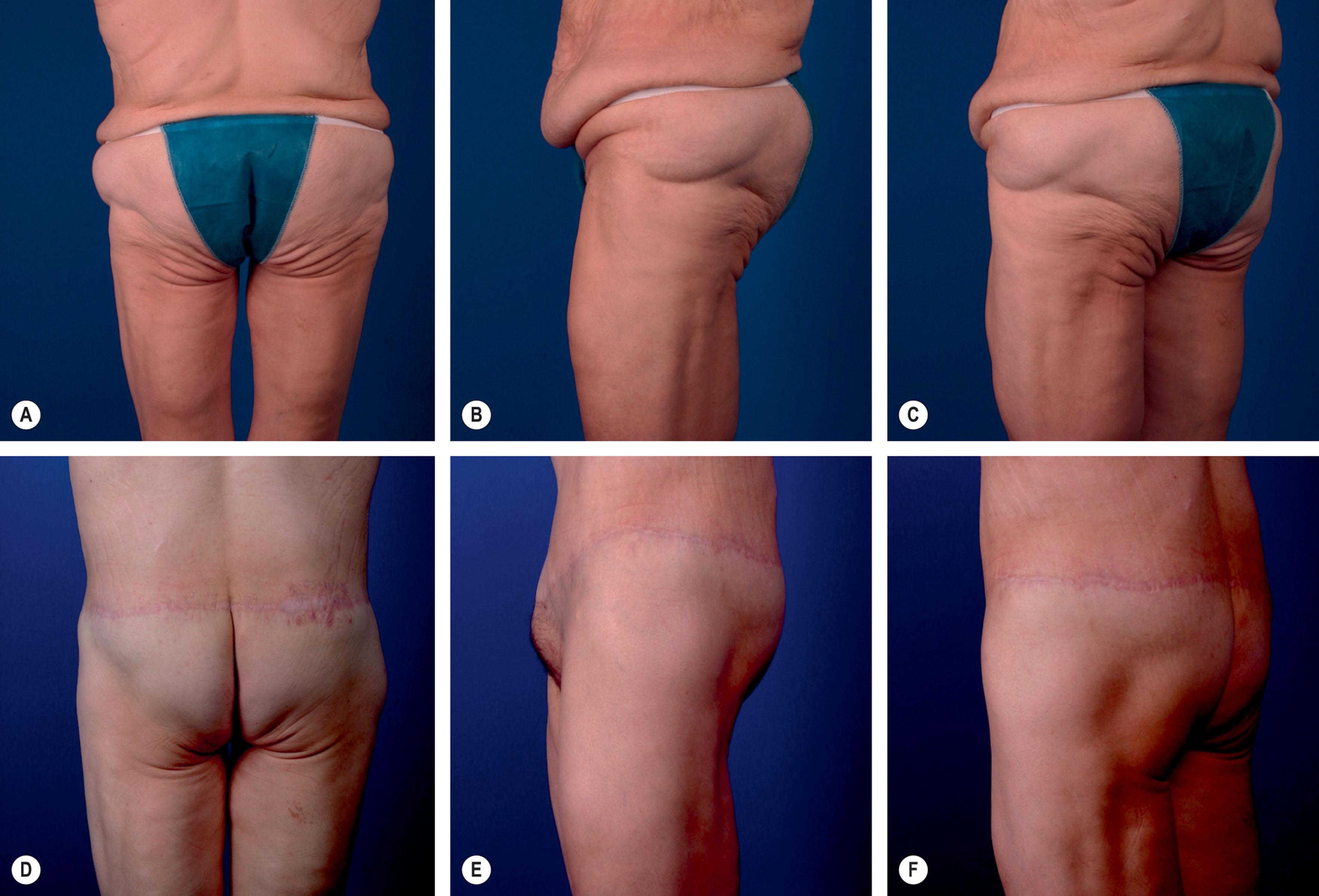
The massive weight loss patient represents another end of the spectrum. Weight loss secondary to exercise or bariatric procedures often occurs in a variable manner. There is data to suggest that certain areas of adipose tissue on the body are more resistant to weight loss than others. The genetic programming of the resistant adipocytes differ from more responsive areas, suggesting a genetic role of different somatotypes. Some somatotypes such as “apples” seem to have less adipose tissue in the gluteal region. “Pears” tend to retain more tissue in the gluteal region. These somatotypes can also affect the shape of the pelvis and buttock shape. Final post-weight loss body mass index (BMI) has a significant impact on these findings, irrespective of body shape. Many MWL patients tend to lose some volume in the gluteal region.
The MWL patient also develops skeletal changes that may contribute to platypygia ( Fig. 34.2 ). Morbid obesity is a restrictive lung disease with an obstructive component that is more pronounced in the supine position. Expiratory flow limitation in the supine position may lead to pulmonary hyperinflation and intrinsic positive end-expiratory pressure (PEEP). This is thought to play a role in positional orthopnea reported by obese patients. Over time, obese patients are hypothesized to develop thoracic skeletal expansion to accommodate this increased need for functional reserve capacity and to accommodate hyperinflation. Thoracic kyphosis or scoliosis secondary to thoracic spine compression and anterior inclination of the pelvis also occurs. Inadequately treated post-bypass hypocalcemia, vitamin D malabsorption, secondary hypoparathyroidism, and independent negative bone remodeling modulated by either sex hormones or serum telopeptides may also worsen these weight-related skeletal changes. These skeletal changes are permanent and worsen pre-existing primary or secondary platypygia caused by loss of adipose tissue in the gluteal region. The skeletal findings also contribute significantly to asymmetry that is resistant to body contouring.
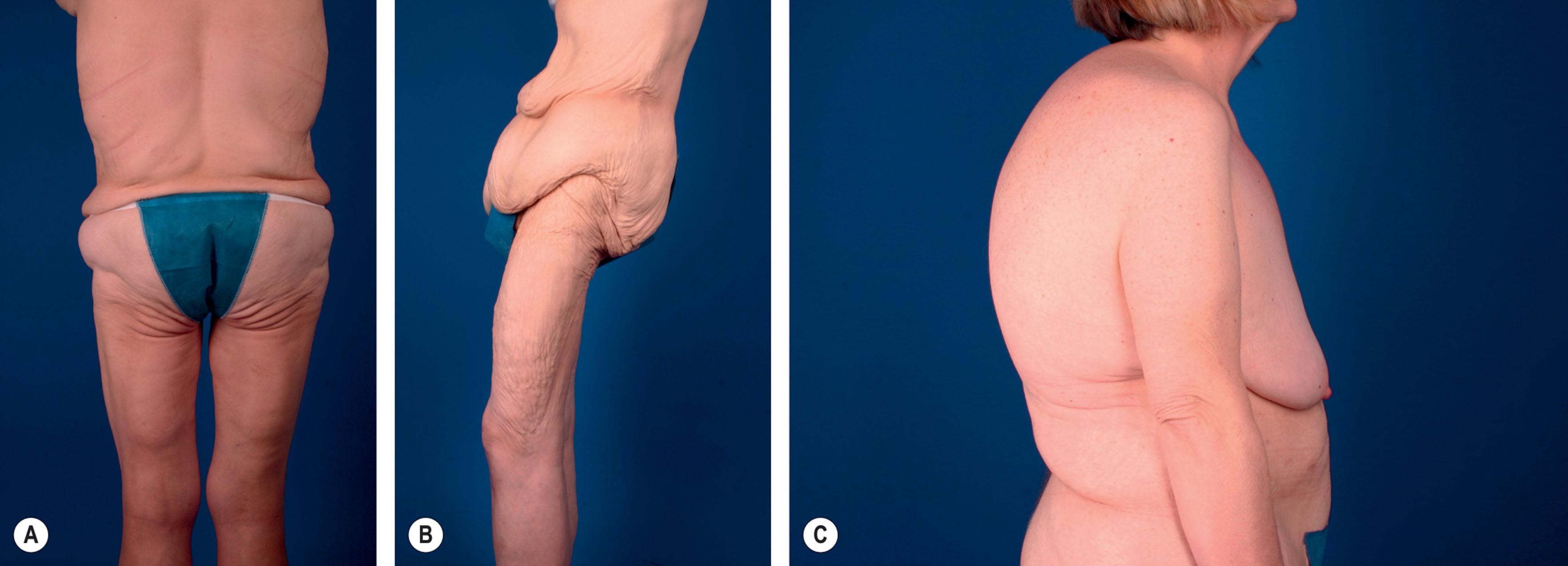
As demand for gluteal enhancement and the collective experience with the various forms of alloplastic and autologous gluteal augmentation have grown, a consensus has emerged that limitations in gluteal implant design have limited the success and widespread acceptance of alloplastic gluteal augmentation in the US. Nevertheless, these techniques are still applicable in certain subsets of well-informed patients. Alloplastic techniques are very successful in enhancing the gluteal aesthetic but have limited applicability because of their significant long-term complication rates. The “aesthetic success” of these alloplastic procedures has inspired the authors and others to continue to refine several autologous flap techniques for gluteal augmentation. Furthermore, the impact of implant position on buttock projection and aesthetics has significantly influenced autologous augmentation techniques.
Submuscular implants have the highest point of maximum projection in comparison to the ideal at the level of the mons pubis. Intramuscular implants lower the point of maximum projection, but they are still higher than ideal. Subfascial implants lower the point of maximum projection closest to the ideal at the level of the mons pubis ( Fig. 34.3 ).
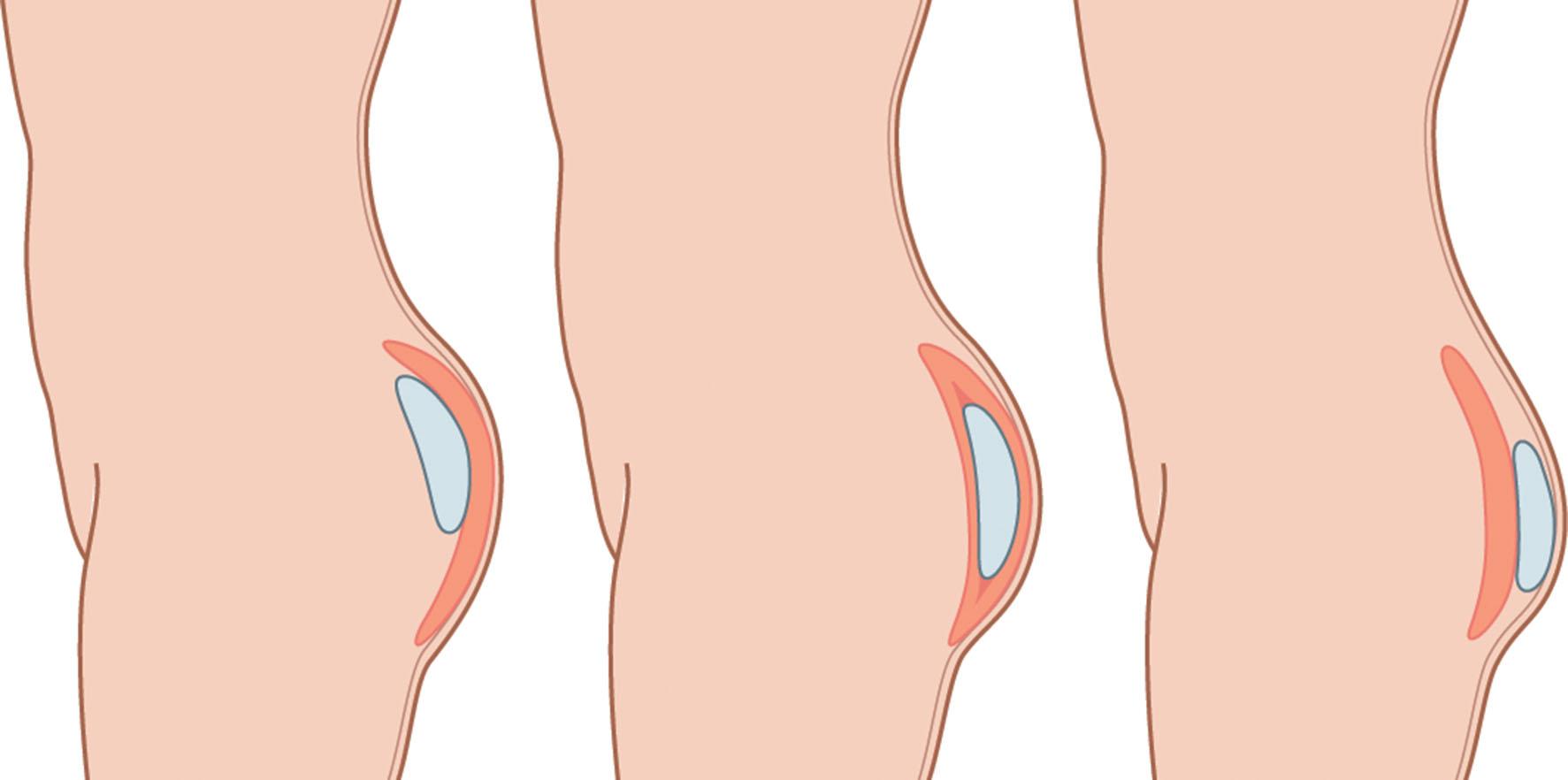
The MWL patient with significant skin excess and buttock ptosis is not the ideal candidate for either alloplastic augmentation in any of the three accepted planes: subfascial, intramuscular, submuscular; nor autologous fat transfer. The combination of an excisional procedure (CBL/EBL) characterized by a higher than average minor complication rate, with alloplastic augmentation procedures where infection would be catastrophic, seems imprudent. Recently, several authors have reported their experiences with “hybrid” procedures which combine smaller alloplastic implants with autologous fat transfer in both the aesthetic and MWL populations. This approach seeks to address the known complications of larger implants with supplemental augmentation and lateral filling to address the aesthetic limitations of the smaller implants. De-epithelialized flaps have been used in gluteal contouring for some time. Published references to the use of autologous tissue in preventing gluteal deformities with CBL were also reported but lacked significant detail and did not substantiate their potential for augmentation. The description of the superior gluteal artery, inferior gluteal artery, and transverse lumbosacral back flaps and their vascular supplies also bolstered the clinical viability of this approach. More recent anatomic studies have further refined our knowledge of the vascular anatomy of the gluteal region.
The island AGA flap, one of the earliest techniques, simulated the round, non-anatomic design of submuscular gluteal implants. This flap is based on perforators from the superior gluteal artery, which are preserved by restricting undermining of the flaps. Hunstad has reported a variation of the island flap, an imbrication flap, which utilizes a purse-string suture to enhance the projection of the flap. Colwell described a variation of the island flap based on a superior gluteal artery perforator (SGAP) flap design ( Fig. 34.4 ). Pascal, Raposa-Amaral, and Kohler all proposed variations of the SGAP island flap with incremental recruitment of additional surrounding tissue to enhance outcomes ( Fig. 34.5 ). While projection is enhanced significantly with these incremental flaps, the point of maximum projection remains high compared to alternative flap designs. Flap dissection that limits undermining and mobilization of the flap from the original donor site in order to preserve vascularity is the main limiting factor. Long-term augmentation results with these approaches have been disappointing in the author's experience. Higher than ideal gluteal projection and lack of inferior pole projection continue to plague the aesthetic outcomes of these techniques. These shortcomings led to the development of the author's preferred technique, the moustache autologous gluteal augmentation (AGA) flap ( Fig. 34.6 ), which is one variation of a transpositional flap. The moustache AGA flap utilizes the back and lateral flank tissue as a partial island and partial transposition flap based on perforators from the superior gluteal artery and lumbar perforators. Inferomedial transposition of the “handle-bar” part of the moustache AGA flap allows recruitment of additional tissue for augmentation purposes as well as lowers the point of maximum projection to the level of the mons pubis, which is more aesthetically harmonious. Loose imbrication of the flap with sutures allows for the formation of an “anatomically” shaped autologous implant reminiscent of the alloplastic procedures. The central area of the flap tissue is typically divided to allow for easier closure and turned inferolaterally to be incorporated into the flap. Rohde also proposed a partial transposition flap to lower the point of maximum projection of the autologous flaps to enhance outcomes. Sozer, in multiple reports, proposed a gluteus maximus muscle turnover flap based on partial dissection of the gluteus maximus muscle to enhance projection and reach of the flap to the mid to lower pole of the buttock with pleasing results. Based on the published results and a critical assessment of aesthetic outcomes, the Centeno–moustache transposition flap, or one of the other iterations as described by Rohde or Sozer et al ., likely represent the procedures of choice where significant, long-lasting aesthetic augmentation is desired and a lower point of maximum projection is critical for a harmonious outcome (see Fig. 34.6 ).
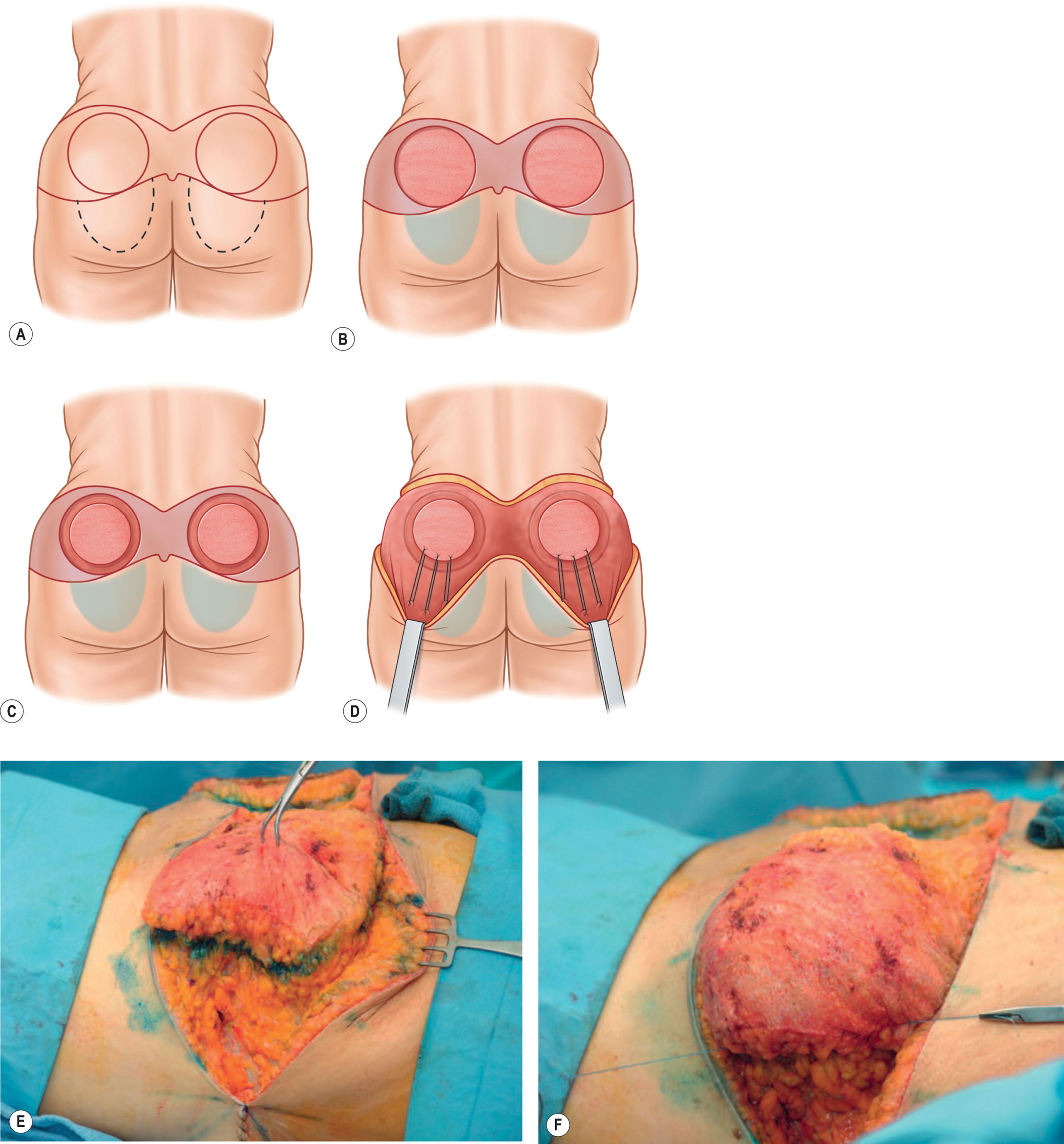
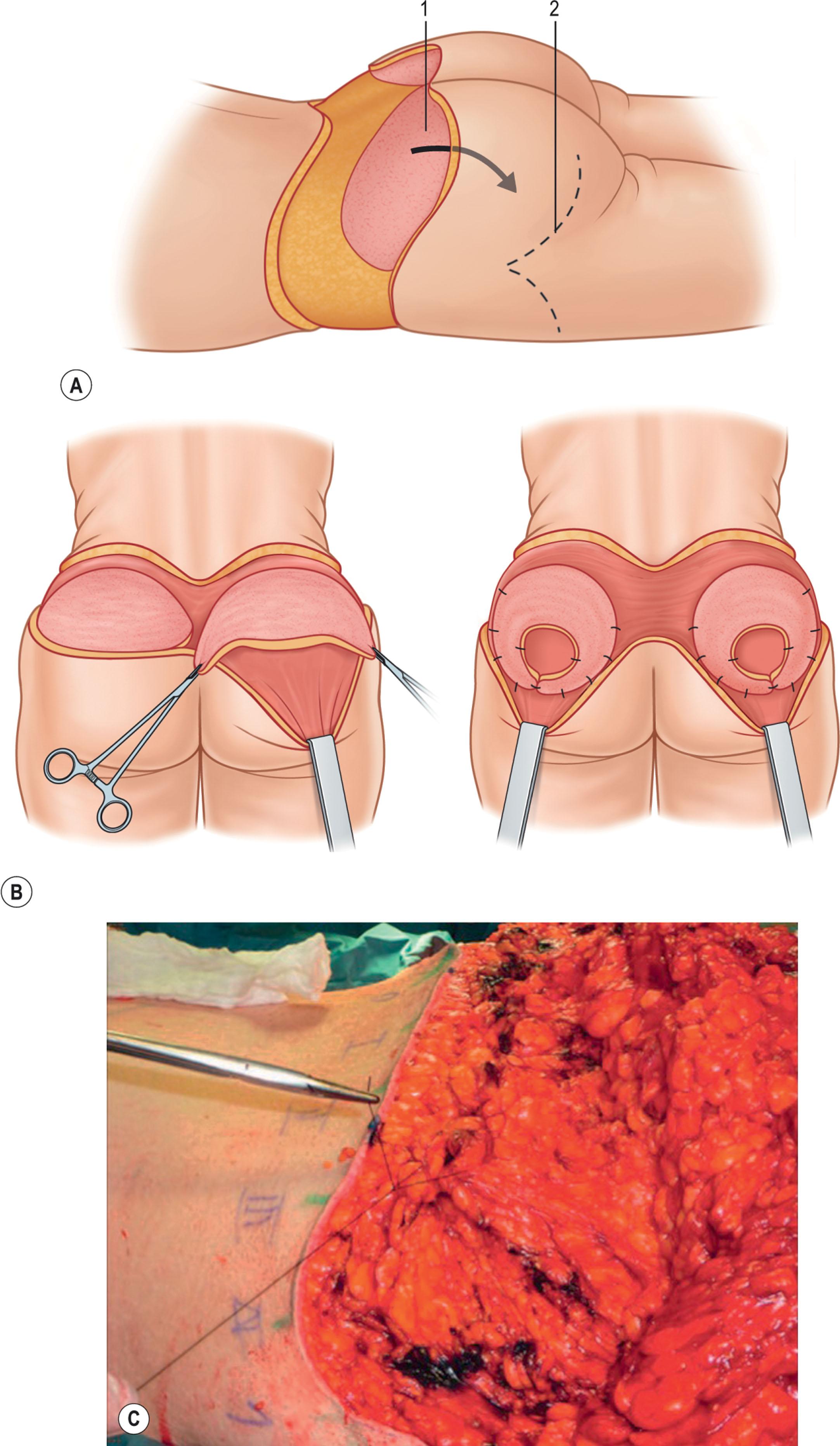

Become a Clinical Tree membership for Full access and enjoy Unlimited articles
If you are a member. Log in here